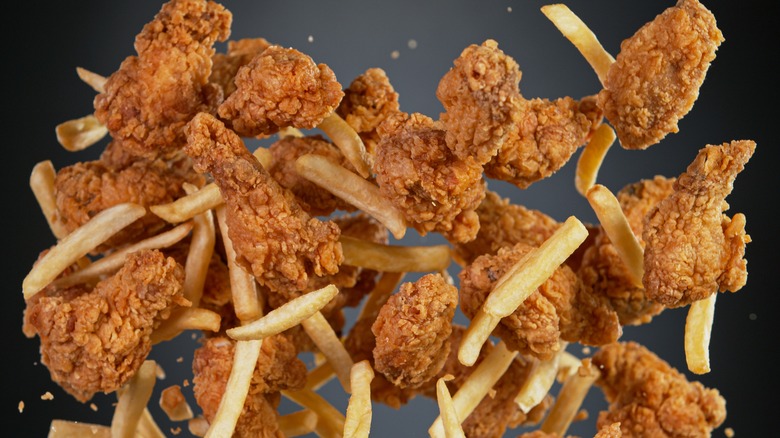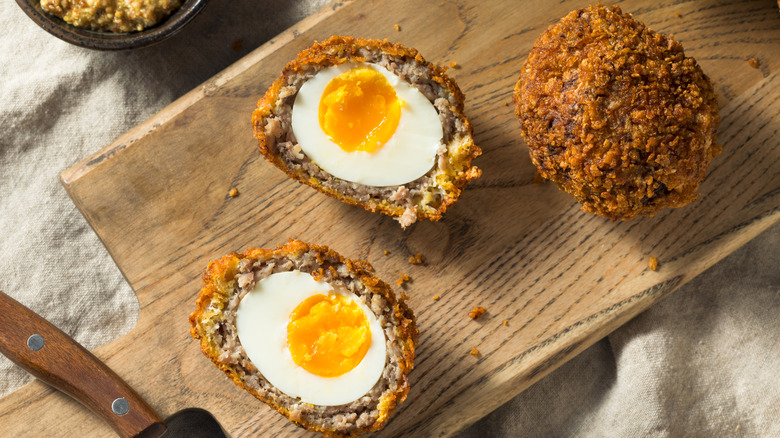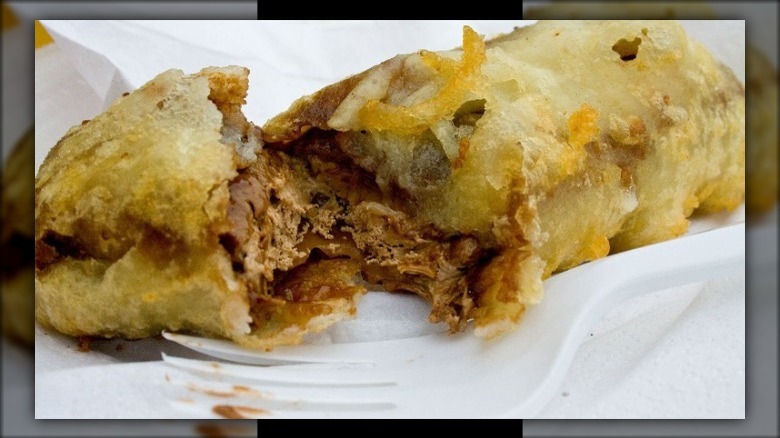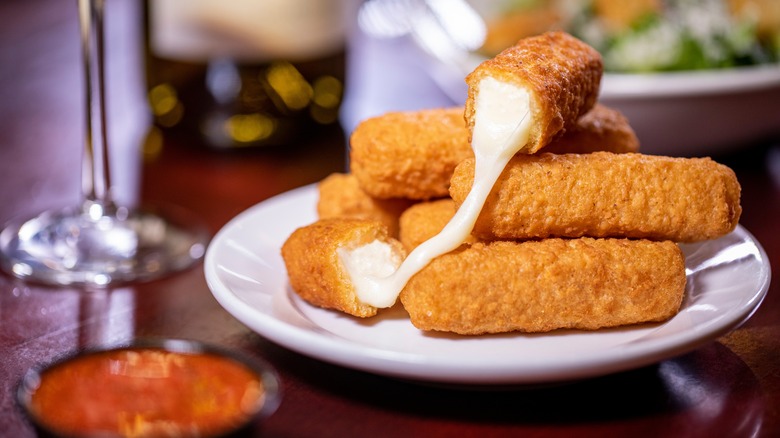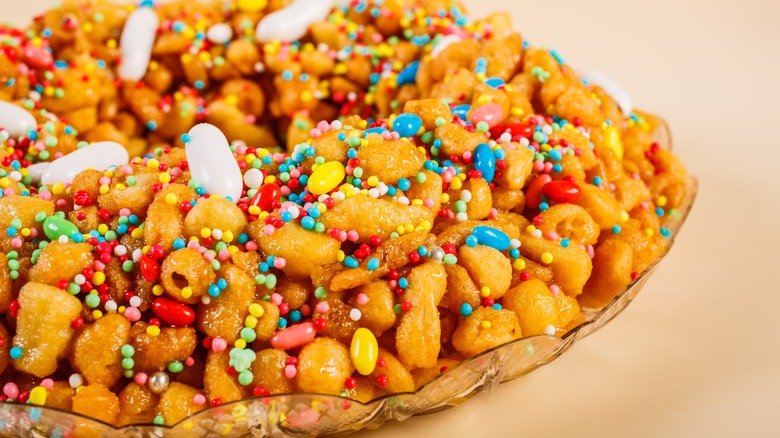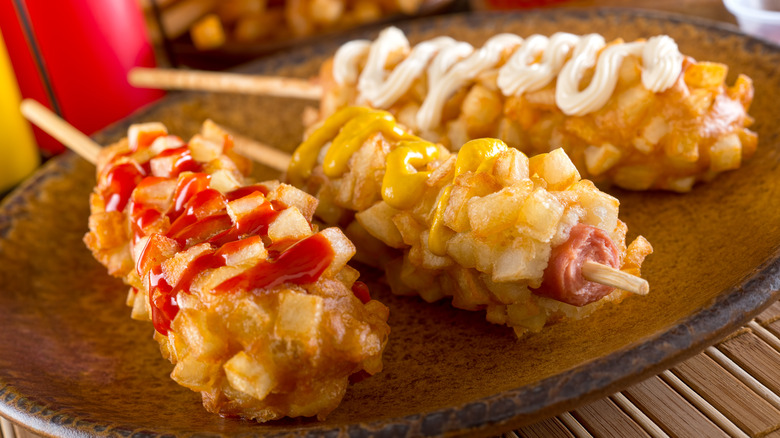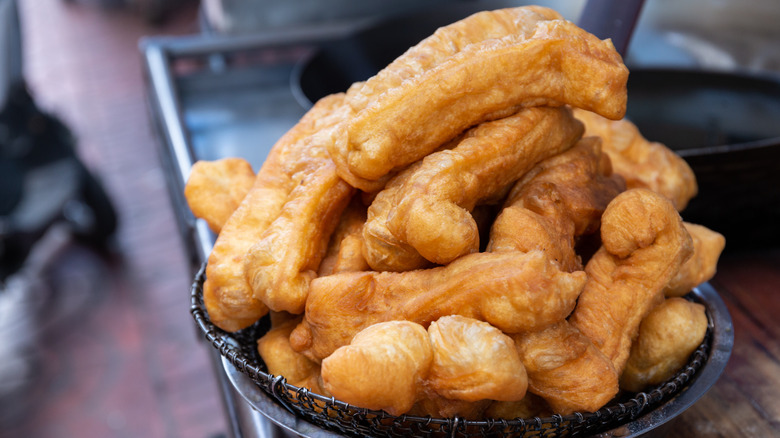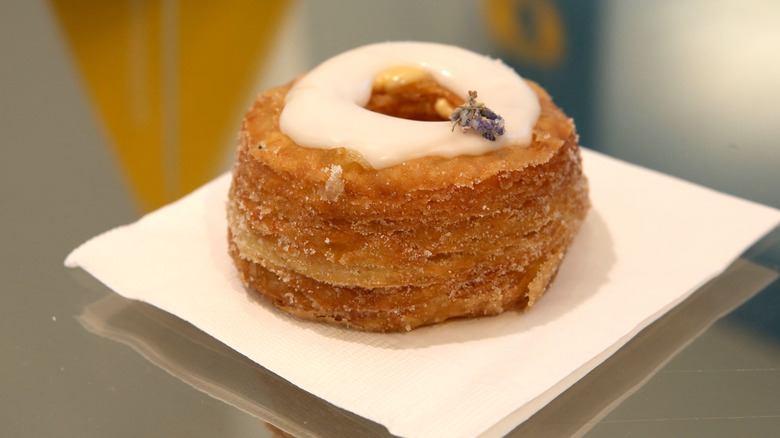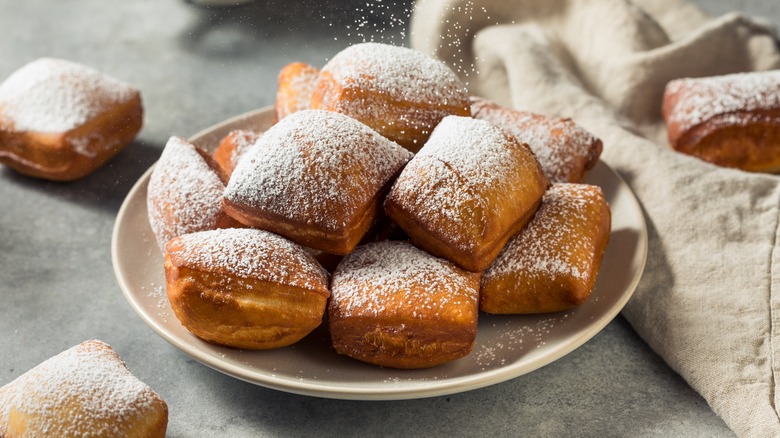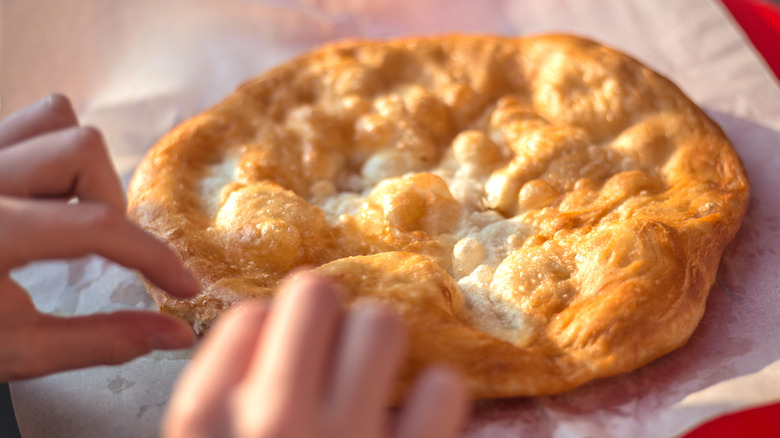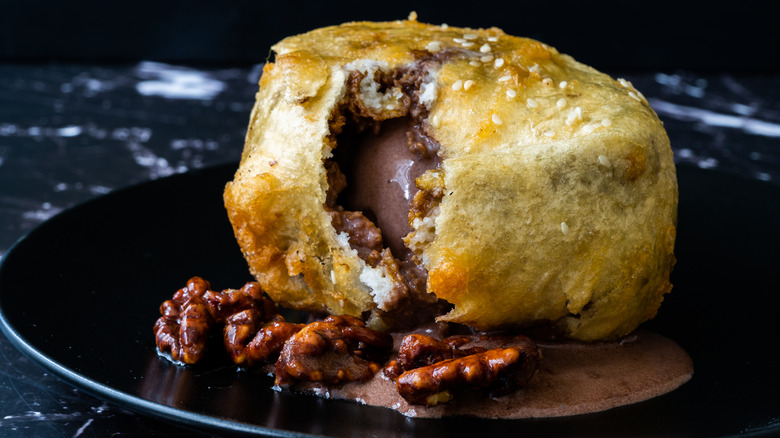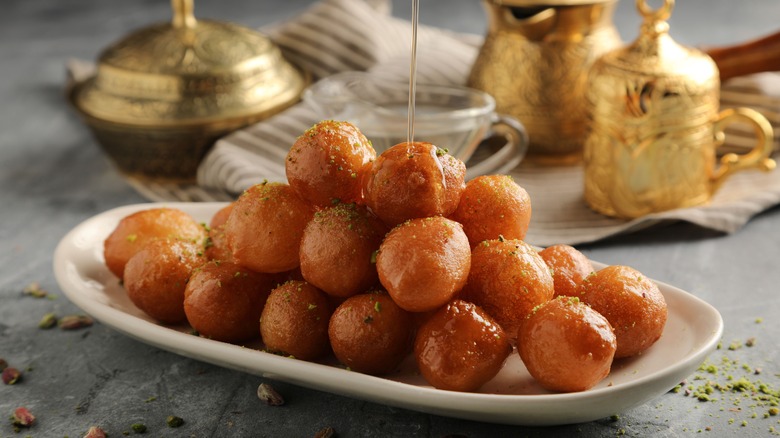29 Deep-Fried Foods You Need To Try Before You Die
It's impossible to confirm who was the first who thought that submerging food into sizzling oil would result in something great, but we should all be thankful as the genius technique gave us some of the best things in life, such as doughnuts, fried chicken, and fish and chips. According to Business Insider, the Spanish and Portuguese were already deep-frying seafood by the 13th century, and by the 19th century, deep-frying was standard practice worldwide.
The popularity of deep-frying isn't difficult to justify. The technique is practical, cheap, and quick, and most importantly, anything you put in hot oil will taste great. But is everything truly better fried? We can't claim for sure, but turning any food product into a golden, crisp, and crunchy bite can't be bad. This is not the place to discuss the health aspect of fried dishes. We will focus on all those mouthwatering treats that come out of the deep fryers with beautifully crisp shells and warm, gooey centers. Though most food can be made tasty by frying, this round includes only the best sweet and savory deep-fried treats that you should try at least once in your life.
Falafel
Falafel is a crispy fritter with a dubious origin and many regional variants. It consists of a thick legume paste traditionally made with chickpeas or broad beans. The paste is shaped into balls (sometimes with a hole in the middle) or elongated patties, which are then fried until crisp and golden. The seasonings inside falafels can vary but typically include garlic, onion, and herbs. When fried, these crisp, savory bites are usually tucked inside a thin flatbread and come served with tahini, hummus, and pickled or fresh veggies. Falafel started its journey in Egypt or the Levant, but it is now internationally known and appreciated as a nutritious, convenient street snack and a great meat alternative (via Medium).
Doughnuts
Doughnuts are most likely the most versatile fritters on the list. Essentially, any fried pastry could potentially be called a doughnut, which can result in endless varieties. To speak of the doughnut's origin would be a thankless task, considering that the first form of frying dough goes back to the ancient Greeks. According to Eater, the fried doughnut was already familiar in the U.S. by 1750, when the first recipe for a sweet fried dough was published in "The Country Housewife's Family Companion." When talking about American doughnuts, we talk about a leavened dough that is fried and enjoyed as a dessert or a sweet snack. It is usually sugar-coated or glazed and can also be filled with custards or fruit jams. Whichever might be your favorite, you certainly can't live without munching down on this crispy sweet pastry.
Samosa
Samosas are stuffed fried pastries that are one of the best representatives of a classic that will never go out of style. They are best known in India, and the country abounds in various samosa styles that range in shape, size, and ingredients. They usually come in triangle or moon shapes, while the typical fillings include paneer, potatoes, or meat, but the combinations are virtually endless and often regionally influenced. These crisp packets of goodness are a beloved Indian snack and are usually enjoyed as an appetizer in Indian restaurants, but surprisingly, it seems that they didn't originate in India. Samosa developed from sambusak, which first appeared in the Middle East sometime in the 10th century. It spread through the region, eventually reaching India, where it would evolve into one of the quintessential Indian dishes (via India).
Chimichanga
At its most basic, chimichanga is a deep-fried burrito that combines a flour tortilla and various fillings that typically feature the usual suspects, such as ground beef, beans, cheese, and rice. Regardless of the filling, the main prerequisite for any chimichanga is to fry it in copious amounts of oil to attain that crispy crust. It is best served with salsas, guacamole, and sauces (via Fine Dining Lovers).
The history of chimichanga is quite murky, and as LA Times reports, several Arizona-based restaurants take credit for creating this beefy fried dish. Though it is common in Mexican restaurants in the U.S., Phoenix New Times says that you will rarely find it in Mexico, which corroborates the story of its American origin.
Tempura
Tempura is not specifically a dish but rather a technique that showcases how frying can be done differently. Now associated with Japan, tempura was introduced by Portuguese missionaries sometime in the 16th century, as Michelin Guide explains. Through centuries, the technique was perfected and developed from the original lard-fried version, and today we mainly talk about eastern- and western-style tempura. The former relies on flour and water, adds an egg to the mix, and uses sesame oil for frying, whereas western-style usually entails slow frying in salad oil. Virtually any food can become tempura, and the creative combinations are endless.
Fried chicken
Fried chicken is a global dish, practically universal to all cuisines. As the BBC reports, love for fried chicken could have something to do with versatility as it is easily tweaked, whether in seasonings, marinades, or frying techniques, meaning that anyone can create a version to suit their taste. Regardless of numerous international variations, Southern-style American fried chicken is the most beloved representative of the group. As the BBC explains, it might have something to do with the sheer passion Southerners used to express their love and promote the dish in and outside the U.S.
Regardless of style, fried chicken will always entail a crispy coating and a luscious chicken hidden underneath. The combination of crunch, spice, and juiciness is heaven for the taste buds and is most likely the main reason fried chicken continually comes up as everyone's favorite.
Pizza fritta
Essentially, pizza fritta is a fried pizza that (unsurprisingly) comes from Naples, the hometown of pizza. The dish is made with pizza dough that usually holds a flavorful tomato and cheese filling. The sealed packet is fried until the crust is crisp and golden, and the filling turns into a creamy, stretchy cheese delight. Fried pizza was born out of necessity during WWII when pizza ovens were scarce and food shortages common. Frying pizza dough proved to be more convenient and affordable, and from this technique one of the most emblematic Neapolitan dishes was born (via BBC).
Scotch eggs
Scotch egg consists of a boiled egg covered in sausage meat and coated in breadcrumbs, neatly packed and fried until crisp and golden. In Scotland, they are a national treasure, available virtually everywhere – from supermarkets to gas stations and restaurants – but if you think that a thing called a Scotch egg would originate from Scotland, you might not be on the right track (via SBS).
Despite their name, Scotch eggs have a more complex origin. They might have been modeled on nargisi kofta, a similar meat-coated egg dish of Indian origin possibly introduced by English soldiers who returned from placements in India. The other theory involves Fortnum & Mason, a department store that also serves food, which claims that it was the first to think of Scotch eggs as a convenient and portable snack for wealthy travelers (via Britannica).
Regardless of these theories, claims, and legends, this fried egg specialty is a must-try in British pubs. It tastes good warm or cold.
Deep-fried Mars bar
Regardless of how you feel about frying candy bars, the deep-fried Mars deserves to be on the must-try list. This unusual concoction consists of a regular Mars Bar – made with chocolate, nougat, and caramel — that is coated in batter and then deep-fried until golden and crispy. Mars Bar originates in Stonehaven, Scotland, where the first deep-fried iteration of the Mars Bar it was made in 1995 at a local fish-and-chips shop. As Press and Journal reports, it resulted from a dare, but it became so popular that it is nowadays called the "unofficial dish of Scotland." Despite some bad press, this legendary candy has endured over the years, it doesn't seem to wade down in popularity, and travel books often list it as an essential dish in Scotland.
Deep-fried cheese
Deep-fried cheese is featured in several national cuisines, and many realized that the already perfect ingredient could be upgraded by deep-frying it. The technique is straightforward; cheese is usually battered and then fried in sizzling oil, creating a crispy layer that coats the partially melted cheese. Mozzarella sticks are one of the best-known representatives and a favorite in the U.S., but this is not the only way to deep-fry cheese.
The Venezuelan version, known as tequeños, is made with cheese sticks wrapped in pastry and then fried. Europeans have similar adaptations, but the one that stands out is the Czech fried cheese in which the whole slice is breaded and fried, and unlike its counterparts, it typically makes a meal of its own (via 196 flavors). Whichever might be your favorite, always eat it freshly prepared.
Croquetas
Croquetas are small Spanish fritters that come in a myriad of flavors. They usually consist of a creamy base made with thickened béchamel that serves as an excellent playing ground for numerous flavor combinations. However, the classic ham (jamón) croquette is the most popular version (via Devour Tours).
Spanish croquettes are traditionally served and enjoyed as tapas – the beloved Spanish tradition of serving small bites with drinks. Unlike the French counterpart made with mashed potatoes, this Spanish version is distinguished for the use of béchamel, resulting in a deep-fried specialty with an incredibly creamy center held together by the crispy fried crust (via Glass and Vine).
Struffoli
Struffoli is the Neapolitan version of crispy fried dough tidbits that are typically enjoyed for Christmas. As Atlas Obscura explains, struffoli probably has Greek origins, and similar varieties exist throughout Italy. What sets these fritters apart is the way they are served. When they attain the right crispiness, tiny struffoli are doused in honey and then covered in candied fruit, candy, and colorful sprinkles, creating an eye-catching treat. Struffoli is typically associated with Christmas, but in Italian American tradition, it is also a part of Easter celebrations.
Coxinha
Coxinha is a Brazilian fritter made with a creamy mix of shredded chicken and local cream cheese (requeijão) that is neatly wrapped with dough. The clever name – coxinha translates as little thigh – is used as a reference to the distinctive shape that roughly resembles a chicken drumstick. After the large croquettes are breaded and fried, the pieces attain a golden crispy crust while the filling becomes a warm, partially melted delight (via The Culture Trip).
Coxinhas most likely originated in São Paulo sometime in the 1800s, but they later spread to other parts of Brazil and are now enjoyed throughout the country. The locals mostly enjoy them as street food or a snack, and they usually come served with different sauces and dips (via Taste Atlas).
Fritto misto
Fritto misto is an excellent example of how Italians applied the idea that everything is better fried. The phrase translates as fried mix, and the dish is precisely that – a mixture of fried ingredients that can include meat, seafood, veggies, or even cream or cookies. On the seaside, the favorite version is a seafood mix that will come filled with crunchy bits of fried calamari, anchovies, or shrimp, whereas the northern-style version is often filled with vegetables and some slightly unusual additions such as fried offal and semolina. In the Marche region, the obligatory addition includes stuffed and fried olive ascolane. These fried mixes make a great snack or an appetizer. Though there are no rules when it comes to ingredients, it always needs to be made fresh (via Fine Dining Lovers).
Korean Corn Dog
You may be familiar with American corn dogs, but the Korean version is an entirely different ball game. Korean Webzine explains that corn dogs first appeared in the 1980s. In the beginning, they were a simple, unpretentious snack: sausages coated in corn batter and then deep-fried. But corn dogs grew into a national craze, which caused the emergence of numerous varieties. The most popular version these days is the one that incorporates chopped French fries in the corn batter. The combinations are endless and may include standard condiments or some traditional options made with kimchi or rice cakes. Some corn dog shops also offer customized options, meaning you can dress them up to your liking.
Youtiao
Youtiao is a humble Chinese snack easily described as the Chinese cruller.It is known under various names, and the early version had a quite distinctive, elongated form that allegedly resembled a human shape; the modern version does not. Youtiao is mostly enjoyed at breakfast, and though it makes a great snack on its own, it also goes well with congee or any other soups or stews. Apart from China, these popular fritters are found in other Asian countries. You will most likely find it at street stalls – don't miss the chance to munch down on a freshly prepared youtiao with its crisp crust and soft, tender center (via Says).
Chile relleno
Fine Dining Lovers describe chiles rellenos as a fusion dish and New Mexican staple that has its origins in Puebla. The dish consists of a large stuffed pepper coated in batter and fried. It is usually made with green peppers that are roasted and skinned before they are filled and fried.
The most common version is made with poblano peppers and stuffed with cheese, usually served doused in red tomato sauce (salsa roja). Variations abound and may include other peppers – they must be large enough to hold the stuffing – beef or pork fillings, nuts, raisins, and different sauces (via Masterclass).
Pakora
Pakora is an Indian staple consisting of various deep-fried ingredients such as green peas or prawns. It is a humble dish enjoyed throughout the country, though it appears in several slightly different varieties and under numerous names, including tele bhajas, begunis, and vengayam pakoras. Experts believe that 16th-century Portuguese traders stopped in India en route to Japan, bringing Indian cooks who made pakora. These Indian cooks must have brought the food to Japan, and the dish became what we know as tempura (via Hindustan Times). Pakora can be enjoyed as a snack, a side dish, at tea-time, or as a meal on its own. Though it is traditionally vegetarian, any vegetable, meat, or seafood can be made into a pakora, and most Indian regions will have a signature version that can differ in the base ingredients, seasonings, or the components added to the batter (via The Better India).
Bitterballen
Bitterballen are small round fritters consisting of meat fillings that have Dutch origins. They typically come served with a mustard dip and make a great pairing with any alcoholic drink. It is best to enjoy them freshly prepared while the center is still warm and gooey (via The Dutch Table). Bitterballen have a long history in the Netherlands. They were allegedly made in the 1700s at a local Amsterdam pub owned by Jan Barendsz, whose wife created these small ragu-filled bites that they later served to their guests. After all these years, these crispy balls remain a favorite Dutch snack (via Bitterballen).
Arancini
Arancini are deep-fried rice balls filled with savory fillings which are fried until the pieces attain a golden, crispy crust. These large fritters hail from Sicily, where they originated in the 10th century. They were named after oranges (arancia), most likely because of the orange color they attain during frying, which resembles that of an orange. Arancini typically hold a savory, meat-based filling, and along with typical round shapes, the one from eastern Sicily may also have a cone-like form (via Best of Sicily).
Fried green tomatoes
Most people associate fried green tomatoes with the traditional cuisine of the American South. The dish consists of thick slices of lightly battered green tomatoes fried in sizzling oil. Though it sounds modest and not even remotely spectacular, the appeal of fried green tomatoes is in the simplicity.
Fried green tomatoes were popularized in 1991 with the eponymous movie that told a story of friendship, support, and Southern hospitality, all paired with some delicious regional dishes. Since then, most believed fried green tomatoes originated in the South, but Smithsonian Mag tells a different story. According to Robert F. Moss, the author of "The Fried Green Tomato Swindle and Other Southern Culinary Adventures," fried green tomatoes were first brought to the Northeast and Midwest, most likely by Jewish immigrants, and only later spread to the South. Leaving the origin aside, fried green tomatoes are an excellent starter that you can eat anywhere, anytime.
Fried artichokes
Fried artichokes are a traditional Roman appetizer. Originally they were called carciofi alla giudia, which can be roughly translated as artichokes Jewish-style. The dish has a long history in the Italian capital, probably originating centuries ago among the Jewish community, hence the name. The artichokes are fried whole, and as they fry, the leaves open and crisp up, creating a delectable fried flower with hidden pockets of salt and artichoke juices. Traditionally, old-school restaurants would fry the artichokes twice for added crispiness (via Eat and Walk Italy).
Cronut
Cronut is one of the contemporary additions to the list. This delicious cross between a croissant and a doughnut may sound strange, but once you taste it, you'll never forget it.
Cronut was invented by a legendary NYC baker Dominique Ansel, who worked on the recipe for three months before it was ready to sell. When it was introduced, the cronut was immediately announced as a star, and Ansel's shop became the trendiest spot in the city, with people lining up in front to get a taste of the famed pastry. The popularity was easy to understand as Ansel's cronut resulted in a flaky and crispy pastry with many layers filled with pastry cream, coated in sugar, and covered in a glaze. Simply put, a definite must-try (via Conde Nast Traveler).
Beignet
Beignets are of European origin – as you might have guessed from the name – but this delicious square of fried dough is intractably related to New Orleans, where it found its spiritual home. A beignet is made with leavened dough that puffs up into a flaky, golden delight when it is dropped into sizzling oil.
There are no rules about when you can enjoy your beignet. It is ideal as breakfast, snack, brunch, late dinner, or all of the above. Just make sure you have the napkin ready, as the generous amount of sugar on top of the beignet will end up everywhere. Ideally, pair the beignet with café au lait to get a taste of this favorite New Orleans tradition (via Cravings of a Food Scientist).
Lángos
Lángos is a Hungarian specialty. It is a round disc of fried dough that can be topped with various savory ingredients. Made with leavened dough, lángos is thinly stretched and dropped into a copious amount of sizzling oil to puff, crisp up, and attain that delightful caramel color. You can eat it as is, but adding a spread of garlic or sour cream with cheese will elevate the dish to the next level. Lángos is traditionally enjoyed as a street snack and lángos stalls also commonly appear during any celebration, gathering, or festivity (via Taste Hungary).
Churros
Churros can be easily described as fried dough sticks, but this overly simple description doesn't do justice to this fried Spanish treat. A churro is made with a runny dough that is dropped through an angular funnel directly into the sizzling oil, and what comes out is an elongated fritter with a crispy exterior and a chewy, tender center. Traditionally, churros are served with hot chocolate, a pairing most symbolic of Madrid, but serving freshly fried churros with nothing more than a sprinkle of sugar will also make for a delectable pleasure. Churros are everywhere in Spain and are a prerequisite at all Spanish celebrations (féria) (via BBC Food).
Fried ice cream
Ice cream is excellent on its own, but have you ever had it fried? If you have yet to have the pleasure, now is a perfect time. First, freeze a baking sheet for a few hours. Scoop balls of ice cream onto parchment paper on the baking sheet. After thirty minutes of freezing, the scoops of ice cream must be thoroughly coated in batter and then dipped into the fryer! The batter will crisp up and create a protective layer that will keep the ice cream nice and cold. Though it sounds like a magic trick, we encourage you to try it to see that there's no big secret – just big flavors and interesting textures.
The origin of fried ice cream is pretty murky, but the most popular varieties include Asian tempura-battered ice cream and a Mexican-style version with cereal and cookie crumb coating (via At Least We Fried).
Kushiage
Japanese have perfected the art of frying, and along with the internationally known tempura, they take pride in another fried specialty known as kushiage. The name encompasses a variety of small-sized snacks that are skewered and then fried in sizzling oil. Though it sounds similar to tempura, the batter for kushiage will include an egg and some bread crumbs, creating a firmer crust than the one delivered by tempura. The skewers are served with a dipping sauce on the side and some pickled cabbage strips that should cleanse your palate before each bite. Kushiage is typically made with beef or pork morsels, lotus root, or fish (via Michelin Guide).
Lokma
A dessert mentioned in the ancient book "One Thousand and One Nights" had to make the list of deep-fried dishes you have to try before you die. In its simplest form, lokma is a deep-fried dessert made with leavened dough shaped into small, round balls. When the bites come out of the fryer, they are doused in honey and then ready to be eaten. This treat is common in many Mediterranean and Middle Eastern countries, where it is typically prepared for festivities and gatherings. Traditionally they are covered in honey or date syrup, but lokmas can also be great with a drizzle of chocolate or caramel (via Dessert Advisor).
